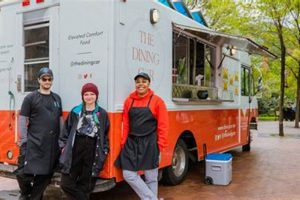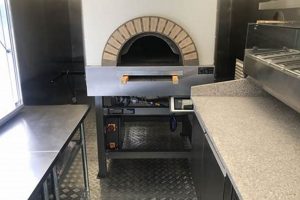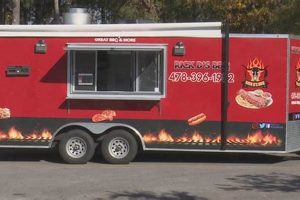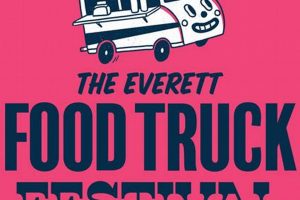A specialized mobile catering unit frequently repurposed from equine transport vehicles. These converted structures combine the mobility of a traditional food truck with the unique aesthetic and often larger internal space of a horse trailer. The resultant business solution offers flexibility in location and a distinctive visual appeal for attracting customers.
This creative application of existing resources presents several advantages for entrepreneurs. Its benefits include reduced initial investment compared to building a custom food truck from scratch, a readily customizable interior to suit specific culinary needs, and an instant novelty factor that can draw attention in competitive markets. The concept allows for participation in diverse events, ranging from rural gatherings to urban festivals, enhancing revenue opportunities.
The subsequent sections will delve into crucial aspects of establishing such a mobile food venture. Topics covered will include trailer selection and modification, adherence to health and safety regulations, essential equipment considerations, and effective marketing strategies tailored to maximize success in this niche market.
Essential Considerations for a Mobile Culinary Venture Utilizing Repurposed Equine Transport
The following guidance outlines key aspects of establishing and operating a successful mobile food business employing a converted horse trailer.
Tip 1: Trailer Integrity Assessment: Prioritize a comprehensive structural inspection. Engage a qualified mechanic to evaluate the frame, axles, and suspension. Repair any rust or damage before commencing modifications. Structural soundness is paramount for safety and longevity.
Tip 2: Strategic Layout Planning: Optimize interior space. Prioritize workflow efficiency by carefully mapping out equipment placement. Consider factors such as food preparation areas, cooking zones, serving counters, and storage. A well-designed layout enhances productivity and reduces operational bottlenecks.
Tip 3: Compliance with Health Regulations: Thoroughly research and adhere to all applicable local and state health codes. This includes requirements for water supply, waste disposal, ventilation, and food handling practices. Regular inspections are crucial to maintain compliance and ensure food safety.
Tip 4: Electrical System Capacity: Ensure the electrical system can adequately support all equipment demands. Consult with a qualified electrician to determine the necessary amperage and install appropriate wiring, outlets, and safety features. Insufficient electrical capacity can lead to equipment malfunction and safety hazards.
Tip 5: Secure Equipment Mounting: Properly secure all cooking equipment and appliances to prevent movement during transit. Use appropriate mounting brackets, restraints, and tie-downs. Secure mounting minimizes the risk of damage to equipment and potential safety hazards.
Tip 6: Effective Ventilation System: Implement a robust ventilation system to remove smoke, grease, and odors. Install a commercial-grade exhaust hood with appropriate filtration. Adequate ventilation improves air quality and creates a more comfortable working environment.
Tip 7: Eye-Catching Exterior Design: Invest in a visually appealing exterior design that reflects the brand identity. Consider professional painting, custom graphics, and strategically placed lighting. An attractive exterior enhances visibility and attracts potential customers.
By carefully considering these elements, individuals can maximize the operational efficiency, regulatory compliance, and market appeal. Proper planning and execution are essential for long-term success in this competitive sector.
The subsequent and concluding analysis will synthesize the essential elements of the mobile culinary venture.
1. Structural Integrity
The successful conversion of a horse trailer into a mobile food vending unit hinges critically on the trailer’s underlying structural integrity. The original design of the trailer was intended to withstand the dynamic loads associated with transporting live animals. Repurposing it for food service introduces different stresses. The installation of heavy cooking equipment, refrigeration units, and water tanks significantly increases the static load. Furthermore, the constant movement and vibration during transportation can exacerbate pre-existing structural weaknesses, such as rust or weld fatigue. Failure to adequately address these issues can lead to catastrophic failures, including frame buckling, axle damage, and compromised stability, rendering the unit unsafe for operation.
For instance, a seemingly minor rust spot on the trailer’s frame can rapidly expand under the weight of kitchen equipment and the stress of travel. This deterioration can weaken the frame to the point where it is unable to support the load, leading to a collapse of the structure. A compromised structural frame can also have severe consequences, such as compromising the safety of the people working inside as well as those of customers near the area. Regular and thorough inspections by qualified professionals are paramount to detect and rectify any signs of structural compromise before they escalate into more serious problems. Welding repairs should be performed by certified welders to ensure the integrity of the repairs.
In conclusion, structural integrity is not merely a desirable attribute but a fundamental prerequisite for the safe and reliable operation of a mobile food business housed within a converted horse trailer. Prioritizing thorough inspections, professional repairs, and ongoing maintenance is essential for mitigating risks, ensuring the longevity of the unit, and protecting the safety of all stakeholders. Addressing the structural considerations proactively is an investment in the long-term success and safety of the food vending venture.
2. Equipment Integration
Successful utilization of a converted equine trailer necessitates meticulous equipment integration. Unlike purpose-built food trucks, these trailers often require extensive modifications to accommodate commercial-grade cooking appliances, refrigeration units, and food preparation surfaces. Careful planning is crucial to ensure operational efficiency and regulatory compliance.
- Power Supply and Distribution
Mobile food operations demand a robust electrical system. Integrating generators or shore power connections requires careful consideration of wattage requirements, safety protocols, and code compliance. Improper wiring can lead to equipment malfunction, fire hazards, and regulatory violations. Examples include selecting a generator with sufficient output to simultaneously power refrigeration units, cooking equipment, and lighting, and ensuring all wiring is properly grounded and protected from the elements.
- Water and Waste Management
Food safety regulations mandate adequate potable water storage and wastewater disposal systems. Integrating these systems into a confined space requires careful planning to prevent contamination and ensure compliance. Examples include installing appropriately sized water tanks that meet NSF standards, implementing a gray water containment system that prevents spills and odors, and adhering to local regulations regarding wastewater disposal.
- Ventilation and Exhaust Systems
Commercial cooking generates heat, smoke, and grease, necessitating effective ventilation. Integrating exhaust hoods and ventilation systems into a repurposed trailer requires careful consideration of space constraints and airflow requirements. Examples include installing a properly sized exhaust hood over cooking equipment to remove smoke and grease, ensuring adequate make-up air to maintain proper airflow, and complying with fire safety regulations regarding grease duct cleaning.
- Food Preparation and Storage
Efficient food preparation requires strategically placed work surfaces and storage solutions. Integrating these elements into a limited space demands careful planning to maximize functionality and maintain food safety. Examples include installing stainless steel countertops that are easy to clean and sanitize, utilizing vertical storage solutions to maximize space, and implementing a FIFO (first-in, first-out) system to prevent food spoilage.
These considerations highlight the complexities of adapting a horse trailer for mobile food service. Successful equipment integration requires a holistic approach, encompassing electrical, plumbing, ventilation, and layout planning. By addressing these challenges proactively, entrepreneurs can create a functional, safe, and compliant mobile food business.
3. Regulatory Adherence
The operation of a food vending unit derived from a repurposed equine trailer is inextricably linked to regulatory compliance at the local, state, and federal levels. The establishment of such a business necessitates strict adherence to sanitation standards, food safety protocols, and operational licensing requirements. Failure to meet these standards can result in significant penalties, including fines, temporary or permanent closure, and potential legal ramifications. The unique construction of a horse trailer, originally designed for animal transport rather than food preparation, presents specific challenges in achieving regulatory adherence.
For example, compliance with health codes often requires specific configurations for handwashing stations, food storage, and waste disposal, which may not be inherent in the original trailer design. Modifications to the trailer must conform to building codes and fire safety regulations, potentially necessitating professional engineering assessments and permitting. Moreover, mobile food vendors are frequently subject to inspections by health officials to ensure ongoing compliance with food safety standards. Instances of non-compliance, such as inadequate refrigeration or improper food handling practices, can lead to immediate operational suspension. In California, for instance, specific guidelines outlined by the California Retail Food Code mandate adherence to stringent criteria for water supply, waste management, and food storage within mobile food facilities, including those repurposed from equine trailers.
Therefore, a thorough understanding of applicable regulations and proactive measures to ensure compliance are paramount. This includes obtaining all necessary permits and licenses, implementing robust food safety protocols, and maintaining detailed records of inspections and corrective actions. Addressing regulatory adherence not only mitigates legal and financial risks but also fosters consumer trust and contributes to the long-term sustainability of the mobile food business venture.
4. Space Optimization
The repurposing of equine trailers into mobile food vending units necessitates a keen focus on space optimization due to the inherent spatial limitations. The original design prioritizes horse transport, not food preparation and service. Consequently, every square inch within the trailer must be strategically utilized to accommodate essential equipment, storage, and workspace for staff. This optimization directly impacts operational efficiency, menu capabilities, and ultimately, profitability. Inadequate space management results in cramped working conditions, reduced productivity, and limitations on the variety and volume of food that can be prepared.
Consider the example of a mobile pizza business operating from a converted horse trailer. Without careful planning, the pizza oven alone can consume a significant portion of the available space. Efficient space optimization might involve utilizing vertical storage solutions for pizza boxes and ingredients, incorporating a fold-down preparation surface that can be stowed away when not in use, and selecting a compact, high-efficiency refrigeration unit. Furthermore, the layout must facilitate a smooth workflow, minimizing unnecessary movement and maximizing the speed of service. The spatial arrangement also influences adherence to health and safety regulations. Adequate space for handwashing stations, separate areas for raw and cooked foods, and proper ventilation are all critical aspects that must be integrated into the limited confines of the trailer. The absence of thoughtful space utilization leads to violations, increased safety risks, and compromised food quality.
Effective space optimization within a food truck horse trailer is therefore not merely an aesthetic concern but a functional imperative. It demands a comprehensive assessment of equipment needs, workflow requirements, and regulatory obligations, followed by innovative design solutions that maximize utility within a constrained footprint. This proactive approach to space management is essential for creating a successful and sustainable mobile food vending business.
5. Mobility & Accessibility
The inherent value proposition of a mobile food business centers on its capacity to reach diverse customer bases in varied locations. A converted equine trailer, serving as a “food truck horse trailer,” offers a distinct advantage in this regard. Its towable nature facilitates access to events, festivals, and temporary high-traffic areas where fixed establishments are absent. The size and maneuverability of the trailer influence its ability to navigate congested urban environments or traverse less-developed rural roads. Therefore, the trailer’s dimensions, weight, and towing capabilities directly affect the scope of its potential operational footprint. For example, a compact and lightweight trailer can access smaller events and tighter spaces, while a larger, heavier unit might require specialized towing equipment and be restricted to larger venues with adequate parking.
Furthermore, “accessibility” extends beyond mere physical mobility. It encompasses the ease with which customers can interact with the mobile food vendor. The trailer’s design should facilitate convenient ordering and pickup. Low service counters and clearly marked queuing areas enhance the customer experience, especially for individuals with disabilities. Strategic placement of the trailer at events is also crucial; selecting a location with high visibility and easy pedestrian access maximizes potential sales. The practical application of this understanding involves conducting thorough site surveys to assess accessibility factors, optimizing the trailer’s layout for efficient customer flow, and implementing marketing strategies that communicate the vendor’s presence and location to the target audience. For instance, utilizing social media platforms to announce event locations and providing GPS coordinates can significantly improve customer accessibility.
In conclusion, mobility and accessibility are pivotal determinants of success for a “food truck horse trailer” venture. The trailer’s physical characteristics and operational strategies must be carefully considered to maximize its reach and ensure a positive customer experience. Overcoming accessibility challenges through thoughtful planning and execution expands market opportunities and contributes to the long-term viability of the mobile food business.
6. Visual Brand Identity
Visual brand identity is paramount for food vending units derived from repurposed equine trailers, frequently known as food truck horse trailers. Given their unique aesthetic origins, establishing a cohesive and compelling visual identity is critical for differentiating the business, attracting customers, and conveying a sense of professionalism and quality. The visual elements communicate the brand’s values, culinary focus, and overall customer experience.
- Exterior Aesthetics and Design
The exterior of a food truck horse trailer serves as the initial point of contact with potential customers. Design considerations include paint colors, graphics, logos, and overall visual theme. A well-executed exterior should be eye-catching, memorable, and reflective of the brand’s personality. For example, a trailer specializing in gourmet coffee might utilize a sophisticated color palette and elegant typography, while a barbecue-focused trailer could incorporate rustic textures and bold, graphic elements. Consistency in design across the trailer’s exterior and any accompanying signage is crucial.
- Menu Boards and Signage
Menu boards and signage are essential components of the visual brand identity. These elements should be legible, informative, and visually appealing. The design should align with the overall brand aesthetic, utilizing consistent typography, color schemes, and imagery. Furthermore, the menu presentation should clearly communicate pricing, descriptions, and any special offers. Digital menu boards offer flexibility and the ability to update offerings easily, while traditional chalkboards can convey a more artisanal or handcrafted feel.
- Logo and Branding Elements
A strong logo is the cornerstone of any visual brand identity. The logo should be memorable, versatile, and representative of the brand’s core values. It should be prominently displayed on the trailer, menu boards, and marketing materials. Complementary branding elements, such as patterns, illustrations, and color palettes, further reinforce the visual identity. For instance, a logo incorporating a stylized horse silhouette could subtly acknowledge the trailer’s origins while maintaining a contemporary aesthetic.
- Staff Uniforms and Presentation
Staff uniforms contribute significantly to the overall visual brand identity. Uniforms should be clean, professional, and consistent with the brand’s aesthetic. The style, color, and logo placement should reflect the brand’s personality and values. Furthermore, staff presentation, including grooming and demeanor, contributes to the customer’s perception of the business. Well-groomed and courteous staff members enhance the overall brand experience and reinforce a positive image.
These interconnected elements constitute the core of a successful visual identity for a food truck horse trailer business. A unified and professional visual presence is vital for attracting customers, differentiating from competitors, and building brand recognition. Thoughtful consideration of design elements, consistent application, and a focus on conveying the brand’s values are crucial for success in this competitive market.
Frequently Asked Questions Regarding Food Truck Horse Trailer Conversions
The following section addresses common inquiries surrounding the repurposing of equine transport vehicles into mobile food vending units. The information provided aims to offer clarity and guidance on key considerations for establishing and operating such a business.
Question 1: What structural modifications are typically required when converting a horse trailer into a food truck?
Structural modifications often entail reinforcing the frame to support additional weight, installing ventilation systems, and creating openings for service windows and access doors. Reinforcement is crucial to accommodate heavy equipment, while ventilation systems are essential for compliance with health codes and worker safety. The extent of modifications varies depending on the trailer’s initial condition and the intended culinary operations.
Question 2: What are the primary regulatory hurdles encountered in operating a food truck horse trailer?
Regulatory hurdles typically involve compliance with local and state health codes related to food handling, sanitation, and waste disposal. Obtaining the necessary permits and licenses, including food handler certifications, business licenses, and mobile vendor permits, is essential. Zoning regulations may also restrict the locations where the trailer can operate.
Question 3: What type of electrical system is recommended for a food truck horse trailer?
A robust electrical system is critical to power cooking equipment, refrigeration units, and lighting. Options include a generator, shore power connection, or a combination of both. The system must be properly grounded and protected by circuit breakers to prevent electrical hazards. Consulting with a qualified electrician to determine the appropriate amperage and wiring is highly recommended.
Question 4: How can space be optimized within a limited food truck horse trailer?
Effective space optimization involves strategic layout planning, utilizing vertical storage solutions, and selecting compact, multi-functional equipment. Prioritizing workflow efficiency and minimizing unnecessary movement are key considerations. Custom-built cabinetry and fold-down work surfaces can maximize usable space.
Question 5: What are the advantages of using a horse trailer compared to a purpose-built food truck?
Potential advantages include lower initial investment costs, a unique aesthetic appeal, and the opportunity to customize the interior to specific needs. Repurposing a horse trailer can be a cost-effective alternative to purchasing a new or used food truck. The distinctive appearance can attract customers and create a memorable brand identity.
Question 6: How can the exterior of a food truck horse trailer be designed to attract customers?
The exterior design should be eye-catching, reflective of the brand’s identity, and easily recognizable. Professional painting, custom graphics, and strategically placed lighting can enhance visibility and create a positive first impression. Incorporating the trailer’s equestrian origins into the design can add a unique touch.
In summary, successful food truck horse trailer ventures require careful planning, attention to detail, and a commitment to regulatory compliance. Addressing these frequently asked questions provides a foundation for informed decision-making and increased chances of success.
The subsequent analysis will shift to a discussion on marketing and branding strategies.
Food Truck Horse Trailer
This exploration has addressed the multifaceted aspects of establishing and operating a mobile culinary venture utilizing a repurposed equine transport trailer. Key considerations include structural integrity, regulatory adherence, space optimization, and effective branding. The successful integration of these elements determines the viability and sustainability of the food truck horse trailer business model. The information outlined herein provides a framework for assessing the feasibility, mitigating potential risks, and maximizing the operational efficiency of such an enterprise.
Entrepreneurs considering this path must conduct thorough due diligence, prioritizing safety, regulatory compliance, and a well-defined brand identity. The strategic application of the knowledge presented will position the food truck horse trailer venture for success in a competitive market. Continuous adaptation and a commitment to excellence are essential for sustained growth and customer satisfaction.







